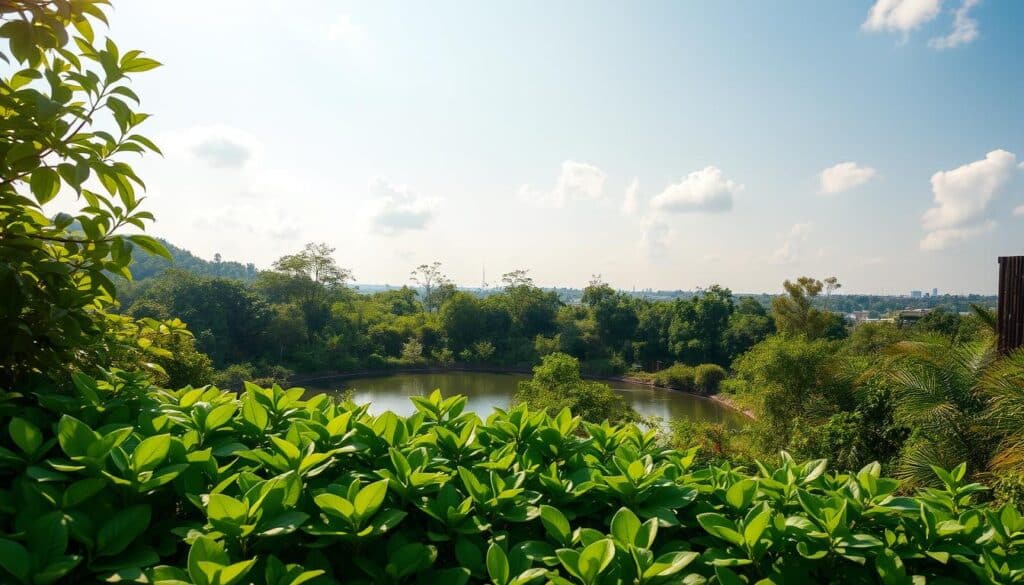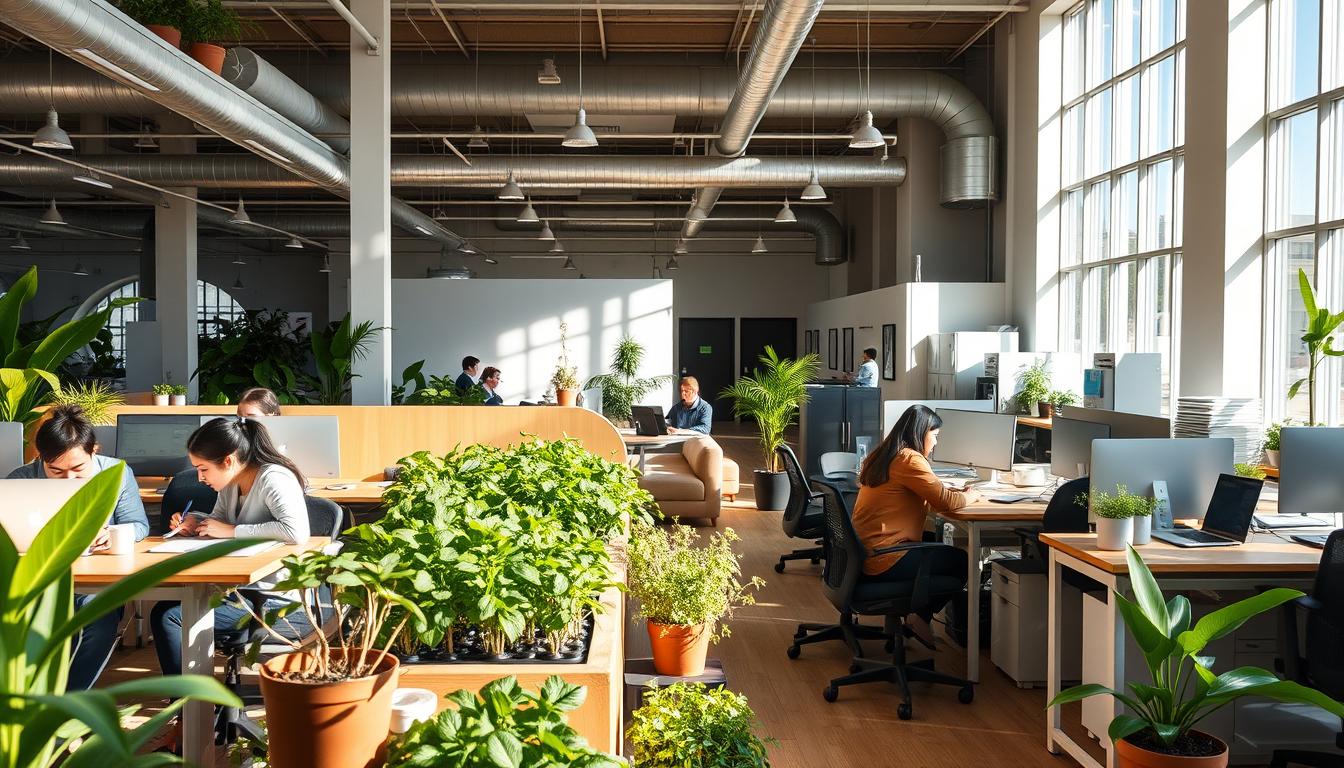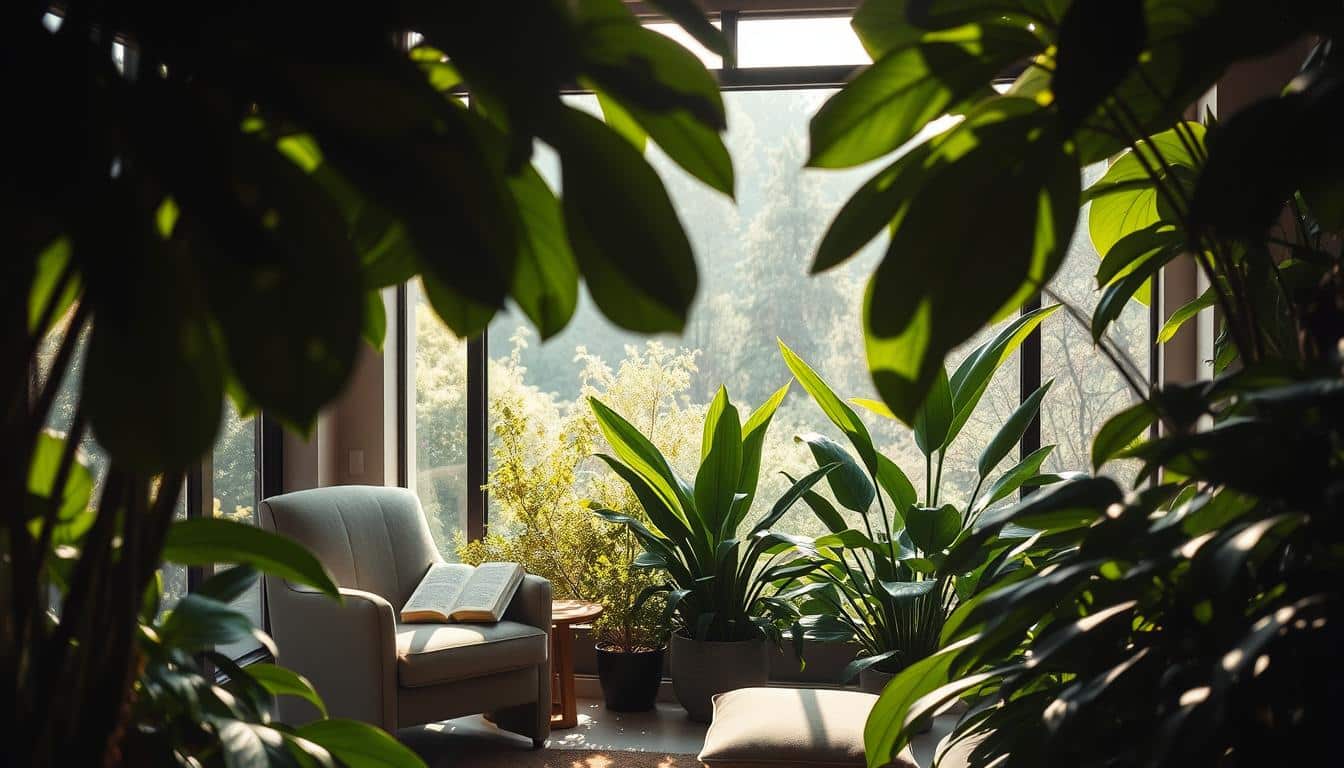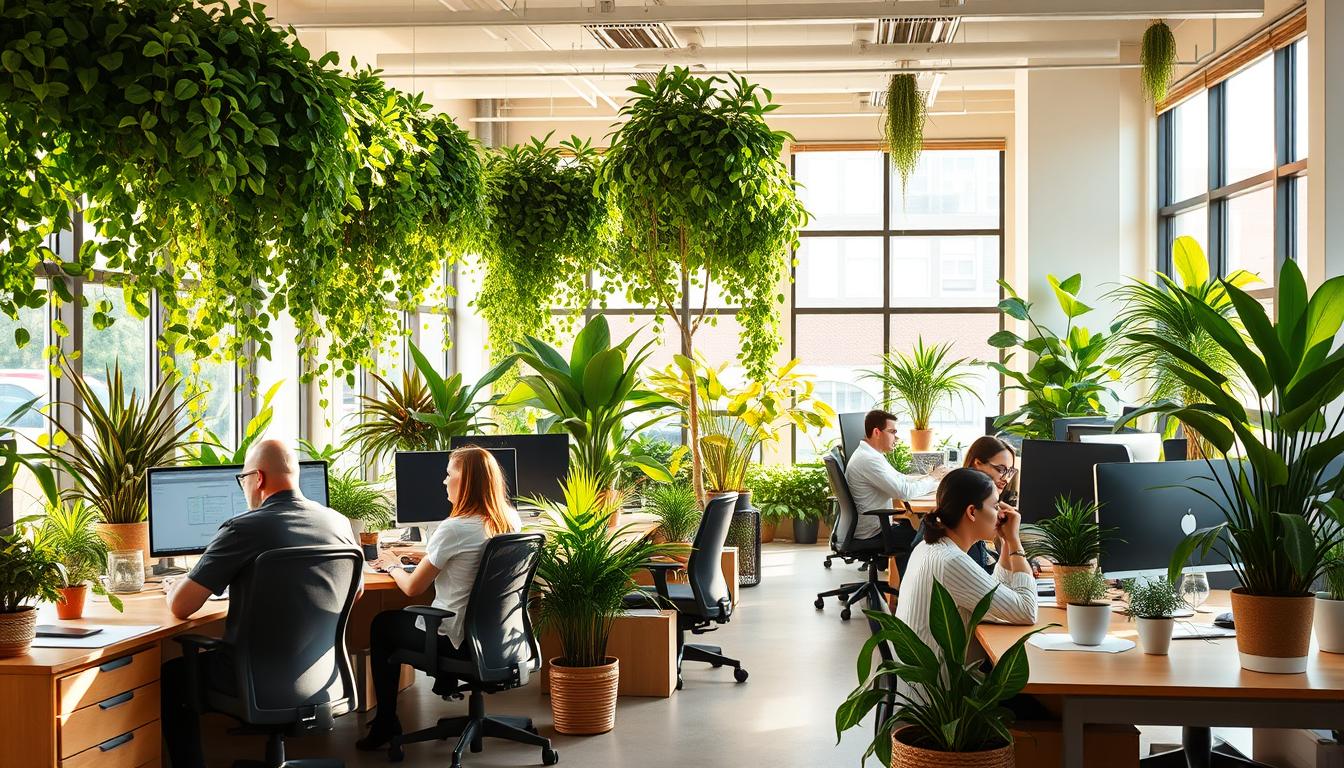The air quality where we live is very important for our health. Plants have a special power to make the air cleaner. This natural way of cleaning the air is not only good for us but also kind to the planet.
Studies keep showing us how plants in cities can make the air better. This makes places where we live and work healthier. By learning how plants help remove pollutants, we realize how vital they are for a better environment.
The Importance of Clean Air for Health
Clean air is vital for our health and happiness. It’s clear that air pollution affects many health issues. Many studies show that bad air quality leads to diseases, affecting millions. Knowing how clean air and health connect shows we need to fight air pollution now.
Impact of Air Pollution on Human Health
Air pollution’s impact on health is huge. Dirty air causes serious health problems, like:
- Respiratory diseases, including asthma and chronic obstructive pulmonary disease (COPD)
- Cardiovascular problems, raising the risk of heart attacks
- Cancer, especially lung cancer from dangerous pollutants
- Inflammation, worsening other health problems
Data on global pollution shows scary trends in health risks from bad air quality. Studies show that air pollution causes about seven million early deaths a year. A shocking 91% of these are due to particulate matter (PM).
Global Air Pollution Statistics
The World Health Organization gives us important numbers on air pollution. They tell us that:
- Around 4.2 million deaths are caused by outdoor air pollution each year.
- Indoor air pollution, from cooking and heating, causes about 3.8 million deaths every year.
- Nearly 90% of kids under five face very high levels of air pollutants.

Understanding Passive Air Filtration
Passive air filtration uses natural ways to clean the air, like plants absorbing pollutants. It doesn’t need energy or machines, making it a good choice for cities. Knowing about passive air filtration helps us see its importance for a healthy planet.
Defining Passive Air Filtration
It’s about plants cleaning the air. They grab dust, take in gases, and break down bad stuff. This helps fight air pollution without fancy tech. The success of this method depends on plant types and the weather.
How Passive Methods Differ from Active Filtration
Passive and active filtration are two ways to clean the air. Active systems use power and tech to catch pollutants. But, passive methods rely on nature’s own cleaning abilities. They aim to improve air with less energy, using the power of life itself.
Passive Air Filtration via Flora: Natural Solutions to Air Pollution
Plants play a crucial role in cleaning the air. Different types battle air pollution and boost air quality. Their presence is key in making city environments greener.
Mechanisms of Pollutant Removal by Plants
Plants use various ways to clear pollutants, thus making the air better. They work through:
- Absorption: Roots take in harmful substances, including metals, helping lessen environmental pollution.
- Adsorption: Leaves catch particles and gases, like carbon dioxide, on their surfaces.
- Biochemical processes: Some plants break down nasty compounds, turning them into safer substances and cleaning the air.
Effective Flora for Air Filtration
Studies point out many plants that are great at removing pollutants. For instance:
- Spider Plant: Perfect for indoors, it’s great at clearing indoor air pollutants.
- Peace Lily: Filters out harmful gases, ideal for homes and offices.
- Rubber Plant: Known for toxin removal and air-purifying abilities.
- Various shrubs and trees: Big plants, like willows and oaks, greatly cut down particulate matter in cities.
The Role of Urban Green Infrastructure
Urban green infrastructure is key to making city air better to breathe. It doesn’t just fight pollution, it also makes cities look nicer. Many examples prove it works well.
Examples of Green Infrastructure
- Green roofs turn the tops of buildings into green spots. They soak up CO2 and help keep buildings warm or cool.
- Living walls make buildings greener by cleaning the air and cooling down the area around them.
- Parks are like big air purifiers. They give us places to play and help cool down cities, making the air cleaner.
- Street trees give shade and make it cooler. They also catch pollutants, helping the environment.
Benefits of Urban Flora in Air Quality Improvement
Studies show green city projects lower pollution in the air. They clean the air by trapping dust and soaking up dangerous gases. Green areas help us breathe easier and fight off city heat, leading to healthier places to live. Adding plants in cities makes life better for everyone.
Plants as Air Quality Enhancers
Many plants help make the air cleaner with their natural abilities. Knowing which ones are best can improve city landscapes. Plants such as spider plants, snake plants, and peace lilies are great at cleaning indoor air.
Types of Plants Effective for Air Filtration
There are many plants that help filter the air in unique ways. Some key examples are:
- Spider Plant: Known for its ability to absorb formaldehyde and xylene.
- Snake Plant: Highly resilient and effective at filtering benzene and formaldehyde, especially during nighttime.
- Peace Lily: Capable of removing toxins such as ammonia, making it suitable for indoor environments.
The Science Behind Plants’ Ability to Filter Air
The science of filtration explains how these plants clean the air. They work effectively because of:
- Leaf Surface Area: Larger surface areas increase the absorption of harmful pollutants.
- Stomatal Uptake: Stomata, small openings on leaves, facilitate the exchange of gases and the uptake of volatile organic compounds.
- Biochemical Pathways: Certain plants utilize specific biochemical processes to break down harmful substances.
Understanding how plants filter air helps us use them better in our cities. This makes our environments healthier.
Factors Influencing Plant Effectiveness in Air Filtration
Many things affect how well plants can clean the air. These include the surrounding environment and picking the right plant types for city areas. Knowing these things helps improve how we clean the air with plants.
Environmental Conditions
The way plants clean the air depends a lot on their environment. Important factors include:
- Light: Enough sunlight helps plants perform photosynthesis, making them better at grabbing pollutants.
- Temperature: The right temperature helps plants grow healthy and filter the air better.
- Humidity: The right level of moisture helps plants work better in capturing pollutants.
- Soil Quality: Soil full of nutrients helps plants grow strong and clean the air effectively.
Species Selection for Maximum Efficiency
Picking the correct plant types is key for the best air cleaning. Traits that make plants more effective include:
- Leaf Morphology: Plants with big and dense leaves are great at catching more pollutants in the air.
- Growth Rate: Plants that grow quickly have a bigger effect on air quality.
- Root Depth: Plants with deep roots do better because they can get more resources, helping them survive in cities.
Case Studies: Successful Applications of Flora in Air Filtration
Cities are turning to green roofs and living walls to clean the air. These case studies show how plants in city designs boost air quality and offer more benefits to the environment.
Green Roofs and Their Impact
Green roofs use plants to cleanse the air and keep buildings cool. Cities around the world see cleaner air after they install green roofs. For example:
- Chicago’s City Hall has a green roof that cuts down on heat and makes the air cleaner with its plants.
- New York’s green roof projects have greatly reduced air pollution, making the city healthier.
Living Walls and Urban Farming Initiatives
Living walls help clean the air by using plants to trap pollutants. They also support city farming, producing local food. For instance:
- San Francisco’s Edible Wall Project combines beauty with usefulness, enhancing urban nature.
- London’s Sky Garden has a living wall that improves small climates and filters out air toxins.
Community Benefits of Passive Air Filtration
Passive air filtration through plants offers many benefits for communities. It goes way beyond just making the air cleaner. Green solutions help with mental health, keep us physically well, and are good for the planet. By adding more green spaces in cities, we can help both people and nature.
Improving Mental and Physical Health
Being around green spaces can make us feel better mentally. It drops stress levels and helps us feel part of a community. Places like parks and gardens push us to get outside. They also give us peaceful spots that make us happy. Studies show that being close to nature makes us want to move more. This leads to a healthier lifestyle for city dwellers.
Enhancing Biodiversity and Ecosystem Services
Adding plants to city designs is great for different kinds of life. By choosing local plants, we can provide homes for wildlife right in our cities. This helps with things like pollination and air cleaning. It also deals with water better. Making our cities greener means they can handle challenges better. This makes life better for everyone living there.
Challenges and Limitations of Flora-Based Filtration
Plants can clean the air, but doing this in cities is hard. Space for plants in cities is scarce. Also, fighting over water and soil makes it tough to use plants to clear the air.
Space and Resource Constraints in Urban Areas
Urban areas have little space for plants because of buildings and roads. This makes it hard to have enough green areas. The main problems are:
- Less soil that’s good for plants.
- Not enough water for all plants, affecting how well they grow.
- Changing seasons can make plants grow poorly.
Potential Negative Impacts from Specific Plant Species
Some plants can actually make air quality worse. They can have downsides like:
- Making too much pollen, which is bad for allergies.
- Releasing chemicals that add to air pollution.
- Spreading too fast and harming local plants.
Future Directions for Research and Development
Research into plant-based air filters offers hope for cities fighting air pollution. Future studies aim to find new ways to use plants in urban design to make air cleaner. We want to create urban spaces that work well with nature and help the environment.
Innovative Practices in Urban Landscaping
We’re looking into fresh ways to use plants to clean the air in cities. Here are key ideas for future research:
- Choosing local plants that do well in the area
- Creating green spaces for fun and clean air
- Using vertical gardens in tight spaces to improve air quality
Role of Technology in Enhancing Plant-Based Filtration
Technology will change how well plants can clean the air. Future research will focus on:
- Monitoring air and plants in real time
- Using data to pick the best plants for specific pollutants
- Smart watering systems to keep plants healthy and effective
Conclusion
Using plants to clean the air is a great and lasting way to tackle city air pollution. By taking advantage of plants’ natural skills to clean air, cities can offer their people a healthier place to live. The role of using green life in this manner is huge, showing it’s key for the future of city planning and growing.
Also, continuing studies are key to make plant cleaning methods better, which could change how we fight air pollution. Getting people involved and getting support from policies are important steps. They make sure we fully use passive air cleaning, better public health, and make city green spaces lively.
Looking forward, using these green strategies will not just make air cleaner but also help city people live better. This wraps up the need to add plant-based ways into our cities. It’s all about growing sustainably and giving everyone healthier lives.



